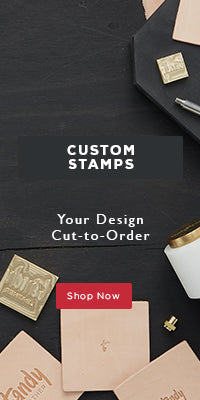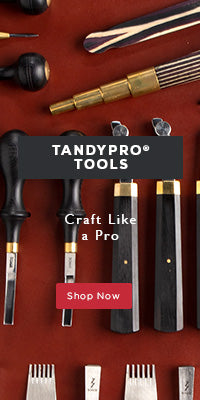All Leathercraft Library patterns and projects are property of Tandy Leather. Projects and patterns available are a part of the Tandy Leather Archive and may contain outdated product information or service offerings. Projects and patterns can be reproduced for personal use by printing, but Tandy Leather cannot guarantee the quality of reproduction or printing due to the image quality available. Some project and pattern themes or motifs may not be representative of Tandy Leather’s current views.

Tandy Skills: Edge Finishing Tutorial

Tandy Skills: Edge Finishing Tutorial
Clean, smooth, professional-looking edges are the key to any leather project, and we've broken down the process in step-by-step detail to help you learn this essential leatherworking skill!
Step 1: Edge Trimming
When creating a finished edge, you first want to trim edges as close as possible to reduce the amount of sanding you will need to do later. Be sure to angle your knife out slightly so that you are trimming on the liner, not your project's face. Keep your blade sharp with regular stropping. For this demonstration, we used the TandyPro® Tools Skiving Knife.
Step 2: Edge Sanding
Our Craftool® Sanding Sticks are almost like an emery board for leather. These sticks have just the right mix of grit to sand down leather edges properly. It's essential to use these sticks in between coats of edge paints to give your projects a professionally finished look. These sticks can also be used to rough up the surface for adhesives on thinner leathers. Use 80-grit sandpaper for rough sanding 120-grit sandpaper for fine sanding.
Always angle your sanding stick or sandpaper away from the face of your project. This ensures you don't change the dimensions of the front of your project.
Make sure the delineation between the face and the liner is visible and straight. You want to see the laminations, and you want them to be perfectly straight.
Step 3: Edge Beveling
The beveler itself should only cut one-third of the stacked leather and should never cut through one entire layer of leather, so the layered edge does not get crushed under burnishing. The goal is to get a nice round edge. Always strop your bevelers to keep them sharp. The beveler should stay at a 45-degree angle when edging to produce the best results.
Step 4: Edge Burnishing
For this demonstration, we used TandyPro® Burnishing Solution; this fiber filler will significantly ease the burnishing process. When liberally applied to the flesh side of a larger piece, it locks down the fibers giving you a professionally smooth back. We are burnishing our edge with our TandyPro® Tools Burnishing Tool Set.
Apply a thin coat of your preferred burnishing solution. Run your burnisher up and down the edge to compress the fibers. Next, lightly sand your edges, apply burnishing solution, and burnish the edge again. Repeat this process until the edge is smooth and reflective, like glass.
If you want to paint, the edges of your project follow all the edge finishing steps, but you do not want to use a burnishing solution. Some people choose not to bevel the edges of their project when painting. This video demonstrates how to apply edge paint in three ways: Craftool® Pro Edge Dye Roller Pen, Craftool® Stainless Steel Edge Paddle, and Wool Daubers. Lightly sand your edge after each coat of paint and reapply until the desired results are achieved.






Comments
Leave a comment